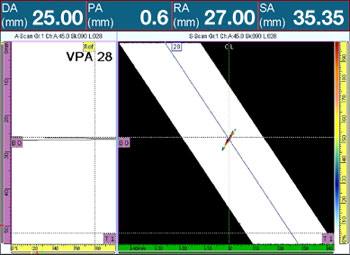Defect Positioning
Phased array instruments, like quality conventional ultrasonic flaw detectors, offer software tools for identifying the position of defects and other reflectors. Typically these locate a reflector in terms of its horizontal position with respect to the probe, its depth with respect to the material surface, and the sound path distance between the beam index point and the reflector. Additionally, when skip paths are employed the instrument should identify the skip leg in which the reflector
occurs.
First, it is important to remember that the beam index point (the point at which the center of the sound beam exists the wedge) is a fixed location for a conventional wedge, and a moving point for phased array wedges. In the case of linear scans, the beam index point will move along the length of the probe as the scan sequences. In the case of angular sector scans, different angular components will exit the wedge at different points.


The screen images below show the presentation of location information from two corner reflectors in a steel plate, one from the first leg signal off the bottom corner and one from the second leg signal from the top corner, seen by a probe at the appropriate position.


Conventional flaw detectors normally use the single beam index point of the wedge as the reference from which depths and distances are calculated. In this example, the top line of the first display indicates that the bottom reflector is 25 mm in front of the beam index point at a depth of 25 mm, and that the measured sound path from the beam index point to the reflector is 35.35 mm. The second display indicates that the top reflector is 50 mm in front of the beam index point at the surface (depth zero), and that the measured sound path from the beam index point to the reflector is 70.71 mm. The first leg versus second leg differentiation is indicated by the readouts 1L1 and 1L2 (short for Gate 1 Leg 1 and Gate 1 Leg 2 respectively) on the lower right edge of the screen.

First leg indication from bottom corner.

Second leg indication from top corner.
Because the beam index point of a phased array probe is variable, a common way of referencing flaw position is with respect to the front edge of the wedge rather than the BIP. The following dimensions can then be calculated from the beam information:
DA = depth of the reflector in Gate A
PA = forward position of the reflector with respect to the tip of the wedge
RA = distance between the wedge reference point and the reflector
SA = sound path length to the reflector
In this display format, the transition between the first and second leg and second and third leg regions of the display is marked by dotted horizontal lines. In the example below, the bottom corner reflector occurs at the transition between the first and second leg zones, and the top corner reflector is at the transition between the second and third legs. Additionally, the position readouts at the top of the screen show the reflector's location.



Continue on to
Interpreting Sector Scans>>
